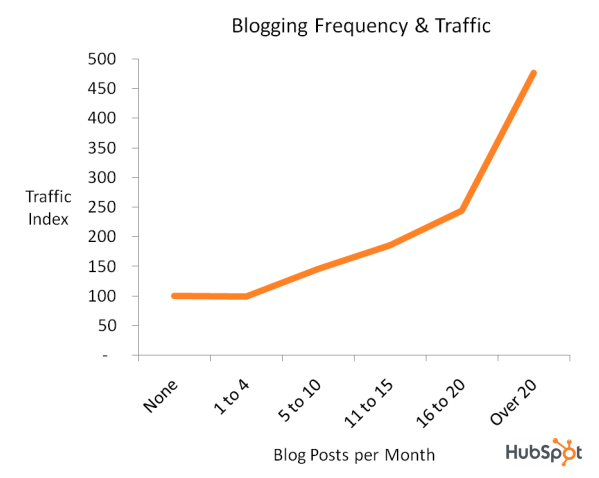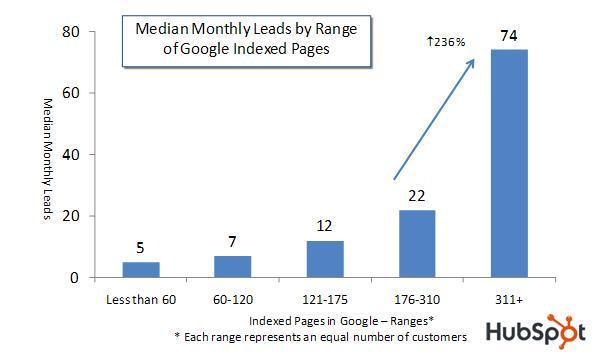If you’ve been involved in content marketing in any way, you’ve probably spotted some of the fight between content quality and quantity.
It’s the age-old debate: marketers will argue for hours over whether it’s more important to prioritize content quality by making small amounts of good content, or quantity, by producing lots and lots of content.
But what if I told you that you didn’t have to choose?
Why Quality Matters
It’s no secret that quality matters.
- Only high quality content appeals to website visitors, and they’ll be turned off any anything that doesn’t impress them.
- This is especially a problem considering the amount of content online – nobody will waste their time with anything that’s low quality.
- Google’s search algorithms are increasingly focusing on people’s enjoyment of content as a factor for rankings.
To ensure that your content marketing efforts pay off, you need to give due attention to the quality of your content.
- Low quality work will likely do more damage than good.
But there’s more to the equation than that: it’s also important to have lots of content.
Why Quantity Matters
While many marketers are keen to focus on creating quality content, the reality is that if you’re only updating infrequently, you’re not going to be giving people enough content to keep them coming back.
- It’s been found that companies who publish over 16 articles a week on their blog (an average of around four articles a week) receive 5x more site traffic than companies who blog less than four times a month (below once a week).
Increasing content frequency even further to updating daily gives an even greater boost to your blog:
- Posting new content daily leads to 5x more site traffic than posting around once per week.
This is likely caused for a number of reasons:
- Frequent updates means lots more content to draw users to your site – each piece of content will add to your traffic, so more content means more traffic.
- With an increase in content, there’s more chance a single article will hit it big and connect with a wider audience.
- More content means regular visitors have more reason to visit regularly – daily updates lead to the creation of a routine that involves checking your website to see what’s new every day.
Building up a huge back catalogue of content is useful for a variety of reasons:
- It increases search rankings because there’s more for a search engine to look through
- It gives site visitors more to click through, keeping on the site for longer.
- Sites with over 310 pieces of indexed pieces of content in Google enjoy 236% more traffic than those with smaller sites.
There’s no denying it: uploading a high quantity of content on a regular schedule is extremely important.
- If you’re focusing entirely on quality and only updating your site on occasion, you’re missing out on a lot of potential traffic that could come from a higher frequency of content update.
To make best use of your content marketing efforts, you want to be creating as much new content as you can, as quickly as possible.
Why Choose?
It seems that in order to succeed at content marketing, both quality and quantity are needed.
- High quality content is essential to building a strong reputation online.
- A large quantity of content is necessary to increase site traffic and keep people coming back to your site.
So why not just make lots of high quality content?
The problem is that creating really excellent content takes a lot of time and resources – and creating a high volume of content is equally expensive and time consuming.
- Because of this, many marketers feel the need to choose between focusing their efforts on quality or on quantity.
- The most successful marketers are those who manage to find a balance between the two and make as much high quality content as they can in a short period of time.
Creating lots of high quality content isn’t impossible – although it does take a lot of careful planning and organization to make sure that the balance between these two elements of your content are just right.
Improving Your Quality and Quantity
People who say you have to choose between quality and quantity aren’t looking at the big picture.
- You definitely need to get a good balance between the two sides of content marketing to make the best use of your time.
- But, it’s possible to get both quality and quantity when you approach your content creation with the right strategy in place.
Here are a few steps I recommend for structuring and planning your content so that you can solid content at a rapid pace, thereby producing both a high quality and high quantity of marketing content.
Set an Editorial Calendar
A lot of the time, your ability to create high quality content at a fast pace will come down to how well organized your marketing schedule is.
- If you’ve got a clear, solid plan for how often your content will be released, you’ll know in advance when you should be finishing each piece of content.
- This will stop content development from dragging on indefinitely, increasing your speed of publishing new content.
- It’ll also ensure that your content stays at a high standard because you’ll have adequate time to prepare it without feeling rushed if you know what schedule it needs to be created on.
You can go further than this by planning not just when content will be finished, but when various parts of the process need to be finished.
- For example, if you set milestones for when to complete research, video filming, initial content drafts and other stages of the process, you’ll decrease the chance that the whole project will go over-schedule.
It can take some practice and experimentation to finding the perfect balance for the time allowances in your schedule.
- To help get the best balance of quality and quantity, it’s worth setting an initial schedule and then regularly reviewing it to see where parts of the process can be sped up or what might need more time to get right.
Once you’ve found peak efficiency, though, you’ll see a significant improvement in the quality of your content, and in the frequency with which you’re able to publish new material.
Explore Topics In Detail
One of the challenges that slows down content production is the process of having to start all over again every time a piece of content is finished.
- Research takes time, as does writing text or producing materials.
Ideally, in order to get the most out of every piece of research you undertake, you’ll want to make use of the same resources multiple times.
This can be done by:
- Repurposing text articles as scripts for videos
- Turning blog posts into white papers
- Using research for a single piece of content as the basis for a multi-piece series on the subject.
If you can cut down the average amount of time you spend researching and preparing each piece of content by using the same material multiple times, you can create a wide variety of pieces of content on the same subject that will be quicker to produce but of a higher quality.
- This can also help you to establish yourself as an authority on a particular subject, gaining you credibility in particular communities.
- What’s more, it’ll help your search engine rankings to be seen as particularly knowledgeable on a particular niche subject.
Just be careful not to overdo things – variety is important to maintaining quality as nobody likes seeing the same thing more than once.
Through reusing or repurposing different pieces, though, you’ll be able to produce multiple pieces of high quality content at once.
Create a Buffer
Are you producing content and then throwing it up online as soon as it’s finished?
This isn’t a great plan for several reasons:
- If anything goes wrong to delay a piece of content it means you’ll be waiting longer before you have something ready.
- By posting immediately you risk overlooking an important error, or failing to think of a perfect way to spice up a piece of content that will only come once you’ve had a little longer to think about it.
In the world of newspaper comic strips, artists are encouraged to create what’s called a strip buffer – a series of prepared comics that are queued up to go out in the near future.
- As each new comic is finished, it’s added to the buffer so that the artist is working as far as a month ahead of time.
Creating a buffer of multiple pieces of content that are ready in advance, and queued up to be published after a pause, you can produce better content on a solid, consistent and frequent schedule.
- A buffer means that if something goes wrong with a piece of content it can be put to one side or postponed without hurting your update schedule.
- It also means that if you do have to delay content creation for some reason, you’ll have time to make it up later without sacrificing the rigidity of your editorial calendar.
Through giving content a longer period between its initial inception and its online debut, you give yourself plenty of time to mentally tweak the concept – sometimes ideas for change will come to you without you even realizing your mind was thinking about it.
This means that you can have longer production times without needing to do more work, whilst still uploading with a high frequency.
Produce Content in Batches
Sometimes it’s getting going on a particular piece of content that makes things challenging.
- This is particularly true of video content – setting up cameras and preparing tools can take a lot of time, as does packing everything away again afterwards.
To make the best possible use of time while focusing on quality, you can tackle the various steps for multiple pieces of content separately.
- For recording a video, try performing research and writing scripts for multiple videos at once, then film them all back to back before taking all of your materials into the editing bay all in one go.
- This approach will cut down on the time it takes to switch between aspects of the project, worrying about lighting or sound clarity, and getting started with each aspect.
- By working in batches, you can get more high quality content finished at a quicker rate.
This works for a variety of other content types as well – podcasts, infographics, and even text content can be sped up by performing all of the research initially, writing a first draft for all articles back-to-back, then editing in a block.
- This process means there’s less time wasted switching between projects, and can help you keep your flow going.
While sometimes it might be necessary to mix things up, creating a batch of content all at once will mean shaving precious minutes from your content creation process, helping you to create more quality content in a shorter time.
Outsource
If you’re concerned about finding the time to produce enough high quality content to meet your needs, you might want to consider outsourcing the creation.
- Dedicated content creation companies or freelancers exist for the sole purpose of producing excellent content on a tight deadline.
- This can mean speeding up the process without seeing a drop in quality, while freeing you up to work on other projects.
It’s not necessary to outsource the entire process.
- If you’ve got a particularly time consuming element of your content creation, such as research, this can be outsourced to someone else so that you can take their notes and use them to create the finished product.
- Alternatively, if you’re making video content, you can use an external editor so that you can focus on producing the initial content and hand off the nitty gritty process of cutting it down.
Many hands make light work, and through getting more people involved you can make sure your content is of a high quality, whilst also avoiding getting bogged down with the slowest parts of the content production process.
Plan Well, Do Better
Ultimately, marketers shouldn’t have to choose between the quality of their content and the quantity they’re producing.
Both sides of the content production coin can be achieved, so long as you:
- Carefully plan out your content
- Make economic choices with your production
- Stick to a solid editorial calendar.
By being smart about content production, you can make high quality content in a large quantity that’ll ensure that you win the content marketing race.
What’s your opinion on the quality/quantity debate? What tips do you have for helping marketers to get the most out of their content? Let me know your thoughts in the comments below:
Images: Flickr, Pixabay, Hubspot, Hubspot, Wikipedia, Pixabay, Pixabay, Flickr, Pixabay, Pixabay, Flickr, Pexels.














